Sep 21 2017
A two-dimensional alloy with an optical bandgap capable of being tuned by the temperature used to grow it has been discovered by Rice University Scientists.
 Subtle changes in growth temperature alters the form of a four-component alloy created at Rice University. The alloy can be tuned to alter its optical bandgap, which may be of use in the design of solar cells and light-emitting diodes. Illustration by Alex Kutana
Subtle changes in growth temperature alters the form of a four-component alloy created at Rice University. The alloy can be tuned to alter its optical bandgap, which may be of use in the design of solar cells and light-emitting diodes. Illustration by Alex Kutana
Scientist Pulickel Ajayan from the Rice lab of materials grew the four-component alloy of transition metals molybdenum and tungsten with selenium and chalcogens sulfur in a chemical vapor deposition furnace. They observed that changes in temperature made subtle modifications in the way atoms assembled and also changed the properties that determine how they absorb and emit light.
Their experiments were based on work performed by the Rice Theoretical Physicist Boris Yakobson, and this work created scores of models in order to predict how different combinations of the four elements should function.
Engineers aiming to develop more-efficient, smaller devices are expected to benefit from this process. The Researchers stated that light-emitting diodes and solar cells might be the first beneficiaries since the bandgap falls in the optical range of the electromagnetic spectrum.
The paper has been published as a cover story in the recent issue of Advanced Materials.
The team headed by Co-lead Author and Rice Research Scientist Alex Kutana produced 152 random models of the material that demonstrated the possibility of tuning the bandgap from 1.62 to 1.84 electron volts by changing the growth temperature from 650 and 800 oC (1,202 to 1,472 oF).
The experimental team headed by Sandhya Susarla then produced and tested the thermodynamically stable materials in a furnace at 50 degree increments. Scientists at Oak Ridge National Laboratory headed by Postdoctoral Researcher Jordan Hachtel developed microscope images that recognized and detailed the position of each atom in the materials.
Labs have made 2-D materials with two or three components, but we don’t believe anyone has tried four. Having four components gives us an additional degree of freedom. With fewer materials, every adjustment you make to change the bandgap turns it into a different material. That’s not the case here.
Chandra Sekhar Tiwary, Co-author and Rice Postdoctoral Researcher
“What we’ve made should be very useful,” added Susarla, a Rice Graduate Student. “For applications like solar cells and LEDs, you need a material that has a broad bandgap.”
Tiwary stated that the material can be tuned in order to cover the whole spectrum of visible light, from 400 to 700 nm wavelengths. “That’s a huge range we can cover by just changing this composition,” he said. “If we choose the composition correctly, we can hit the correct bandgap or correct emission point.”
These materials are arguably the most important 2-D semiconductors because of their excellent optoelectronic properties and low cost. Our high-throughput calculations permitted us to avoid prior assumptions about how the alloy bandgap behaved. The surprising outcome was how regular the bandgap changes were, resulting in optical properties that are both useful and predictable.
Alex Kutana, Co-lead Author and Rice Research Scientist
Co-authors of the paper are Visiting Researcher Vidya Kochat, Graduate Student Amey Apte and Senior Fellow Robert Vajtai, all of Rice, and Juan Carlos Idrobo, a Staff Scientist at Oak Ridge. Yakobson is the Karl F. Hasselmann Professor of Materials Science and NanoEngineering and a Professor of Chemistry. Ajayan is chair of Rice’s Department of Materials Science and NanoEngineering, the Benjamin M. and Mary Greenwood Anderson Professor in Engineering and a Professor of Chemistry.
The research was funded by the Army Research Office Multidisciplinary University Research Initiative, the Air Force Office of Scientific Research and the Frequency Agile Materials for Electronics program, a center of the Semiconductor Technology Advanced Research Network sponsored by the Microelectronics Advanced Research Corp. and the Defense Advanced Research Projects Agency.